They get the best landscapes
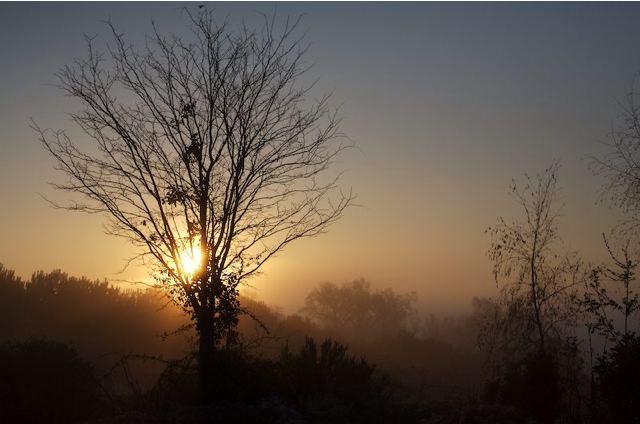
California, 7am yesterday. Canon 5D, 50mm, f/4, ISO 250
It pays to get up early!
They get the best landscapes

It pays to get up early!
f/1.4 is fast!
I have never owned a lens faster than f/2.
That said, the f/2s I have owned have invariably said ‘Leica Summicron’ on them, whether 35mm, 50mm or 90mm. Which is sort of like saying that all your sports cars have been Porsches, meaning the best of breed. At 90mm, that was an apochromatic, aspherical element lens and suffice it to say that the aperture ring on this lens only did two things – it changed the amount of light striking the film and it changed the depth of field. Definition at any aperture was the same, which is to say superb.
So I got to thinking what something faster might be like. Now f/1 is available from Leica only, and that means a second mortgage, so forget it. The f/1.2 lenses out there from Japanese makers have generally poor reputations, being more exercises in marketing, or keeping up with the Joneses if you prefer, so they are of no interest to me. But guess what? Canon just happens to make an f/1.4 for very little money and it’s auto-everything and a nice match for the 5D body. Plus, having grown up with film Leicas, I simply like the 50mm focal length.
So a couple of clicks on the B&H web site and the 50mm Canon f/1.4 was on my doorstep.
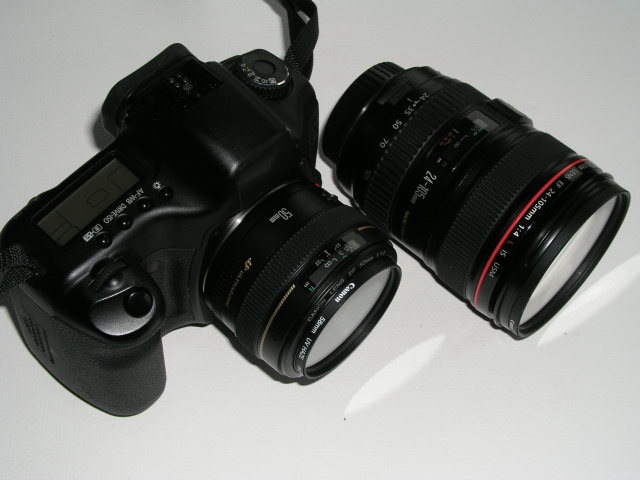
The lens is well made, if not as solid as the ‘L’, meaning the extending focusing mount has a bit of play at the closest focus distance. Auto focus is every bit as fast as the ‘L’ and, strangely, the viewfinder image does not appear much brighter than with the f/4 L – certainly not three stops (8x) brighter. Naturally, as a fixed focus 50mm, it is much smaller and lighter than the L and the absence of Image Stabilization further reduces bulk and weight. The feel, with the lens on the 5D body, is just right – a smaller lens would not feel as good in the hand. The focus ring, if you elect auto-focus override, is a bit blah – it’s geared down approximately 2:1, making for slow manual focusing.
Surfing the web, comments about this lens vary from ecstatic to disappointed, the latter writers damning the optic for soft images at full aperture. How much of this is poor Canon quality control (how much can you expect for $300, after all?) and how much is poor technique I have no idea, but my first ever f/1.4 snap suggests this is a special piece of glass.
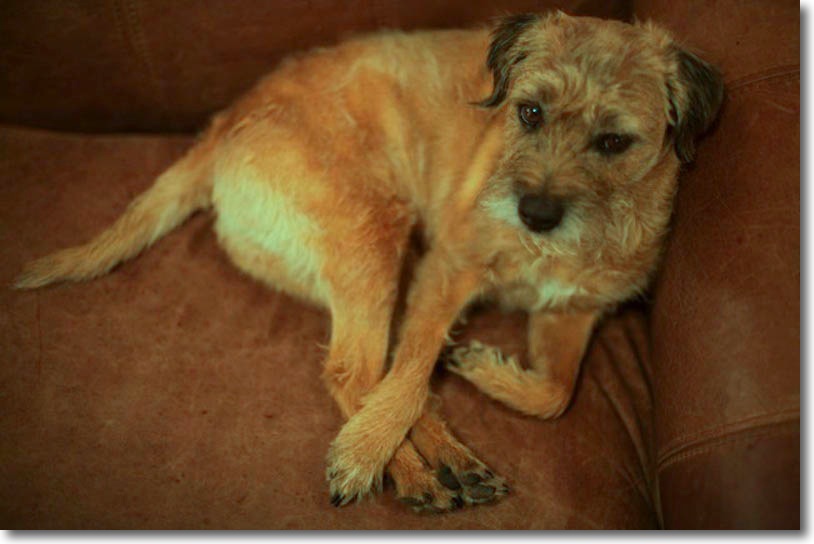
At any rational enlargement ratio, the above snap shows critical sharpness on the right front nails and the eye, which is how I wanted it. The nose, the crowning glory of the Border Terrier, is clearly unsharp, being a few inches closer to the lens.
I took three precautions to avoid definition robbing issues. First, I used a reasonably fast shutter speed of 1/60th second. Second, in the very low lighting in which this was taken, I cranked up the ISO on the 5D to 800, knowing that grain would simply not be an issue with the 5D’s sensor. The aperture was, of course, f/1.4. Finally, and I suspect most importantly, I used Canon’s spot focusing center rectangle to place focus where I wanted it, using a partially depressed shutter buttton to lock in the selected focus point. I wonder whether many users are using the default multi-point focusing feature of Canon’s DSLRs and ending up with the wrong focus point being selected? How on earth can the camera know what you want to focus on using this technology? Optimal auto-focusing depends on a focus point with contrast and detail, as those variables drive auto-focus accuracy. Point your auto-focus camera at a white wall and just watch the mechanism hopelessly try to establish optimal focus. Selecting the nails on Bert’s right front paw satisfied the dictates for accurate focus.
So this inexpensive optic seems like a nice addition to the 5D and some more extended work will disclose whether my first positive experience is borne out over the longer term. If not, I’ll just sell the lens for eighty cents on the dollar and put the loss down as the small cost of a worthwhile experiment.
Some of the best pictures are one hundred yards from your doorstep. Or less..
Given how much time we spend in our homes, it’s surprising that many photographers feel they have to journey to remote, exotic locations in search of picture opportunities. They arrive tired, are in a strange location which they have no time to ‘learn’, and leave frustrated. You must make the return flight and have to make do with whatever weather is around at the time.
By contrast, the circle centered on your home, with a 100 yard radius, provides some of the best photographic opportunities. You know the area, are rested and have no deadlines. There is no return flight. And you can wait for the weather to come to you.
Here are a couple more snaps, taken over the years, all within 100 yards or less of where my bed was the previous night. Today’s entry concludes this five part series.
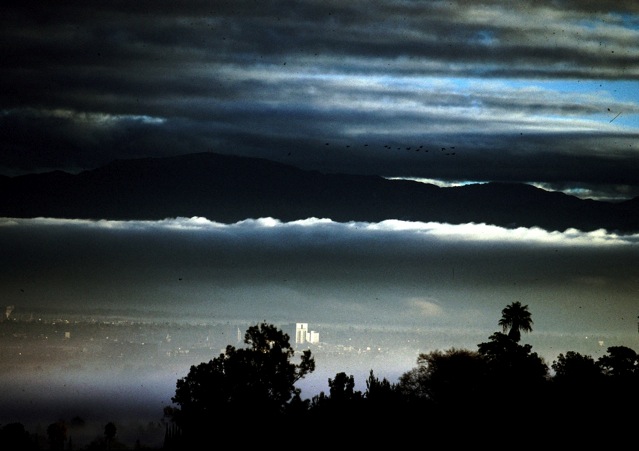
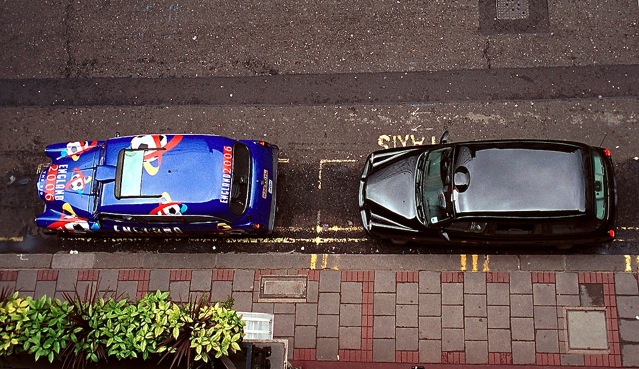
For more on this theme, please click here.
It makes for a lot of photographs.
When the Gutenberg Bible was printed in 1455, it was the first book printed on cheap paper using moveable type. At the time there were maybe a hundred thousand books in print in Europe. Fifty years later there were twenty million. A similar tidal wave is sweeping over photography through the proliferation of web sites.

A couple of weeks ago the U.S. Census Bureau reported that America’s population had crossed 300 million. Even given Government magnitudes of error, meaning the number is 300 million +/- 100 million, that’s a big number.
A few days ago, the Wall Street Journal published a piece on how sales of digital SLRs were booming as photographers wanted something perceived to be better, or at least something without picture destroying shutter lag or camera shake. They mentioned that the percentage of ‘serious’ photographers in the US was 2%. While I have no idea where that number came from, let’s assume a 200mm population of age capable snappers. At 2% that makes for 4 million serious photographers.
Of those four million, lets dismiss 75% as equipment fans who couldn’t take a good picture if it hit them. Down to 1 million.
Of that million, let’s be charitable and say 10% can see rather than just look. 100,000.
Half of these will be mired in old ways, denigrate modern technology and think a web site is a place where ducks with big feet gather. 50,000.
Of those, 50% are passionate enough to show their work. 25,000 real photographers. Why ‘real’? Because if you do not show your work you are not a photographer. No artist can claim the title if no one sees his work as, by definition, photography/art must be seen to be appreciated. By others, that is.
So 25,000 web sites. Now add 25,000 for Europe and 25,000 for the rest of the world and you have 75,000 web sites of good photography, each containing some really good work.
Now add the Gutenberg effect as the populations of China and India and Africa get digital cameras and you have a quarter of a million photography web sites in twenty years.
Which brings me back to the theme of my entry the other day, No more Great Photographers? The individual has been buried by the very technology that makes his work accessible in the first place and the chance that you or I come across one another’s work in a lifetime are very remote indeed.
Technology as enabler has destroyed the significance of the individual.
So while I love how easy it is to make a picture today, I also rue the lack of fame, or even the prospect of fame, that dooms my work.
And yours.
Enough mounting, framing and hanging for a while.
The goal for my one man show in April, 2007, is to have thirty, framed and glassed large prints on display, maybe supplemented by a couple dozen matted but unframed ones in the saw horses in the gallery.
The first fifteen have been shown here before.
Once the QuickTime image loads – click below – cursor over any of the pictures on the walls and the cursor will change to a finger pointing to a globe. Click and you will be take to a high quality image of the picture. Click the ‘back’ button on your browser to return to the panorama.
I ran out of conventional wall space in the home and the theater so I had to resort to hanging the final fifteen, now that they are framed, in the garage, which offers lots of unused white walls. Not the greatest display space, perhaps, but it beats having the framed pictures standing up against various walls, waiting to be accidentally kicked.
Here’s a fish eye snap of the ‘gallery’ – not high quality but you get the idea:

The production line process I mentioned in my piece on framing made this a reasonably efficient proces, fourteen steps in all, viz:
Cut the mounting tissue* (30 minutes)
Mat* (30)
Name and sign all the prints* (15)
Build frames (33)
Install glass (7)
Clean glass (60)
Install print/mount/mat sandwich* (7)
Insert framing points (15)
Drill holes for wire eyes (15)
Install wire eyes (30)
Install hanging wire (60)
Mark wall at standard heights – 70″ for the landscape prints, 73″ for the portrait format ones (30)
Knock in hangers (15)
Hang prints (7)
* Cotton gloves are worn in the asterisked steps, all of which involve print/hand contact.
Aggregate time for each step is shown in parentheses, above. The total of three hours and 21 minutes does not include the time taken to make the prints – reckon on 15-30 minutes per print. Excluding the printing time, the time per mounted and framed print is around 21 minutes with this production line approach, which is not as bad as you would think, considering that the final product is a professionally mounted and framed print with real glass. (Lucite or perspex may be lighter and less fragile, but attracts dust horribly and just looks cheap with large prints).
Each step is done 15 times before moving on to the next. Phew! It may be tedious but going through this process print by print would take infinitely longer. If you need to make a lot of exhibition prints, I commend this approach to you.
Why all this focus on time? Because time spent framing is time not spent taking pictures.